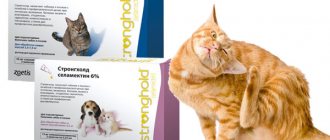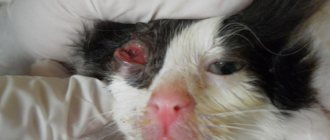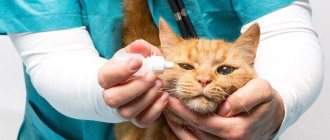Many pet owners have encountered the disease otodectosis. Ear mite drops for cats can successfully fight parasites while eliminating inflammation and fungal infection. But choosing a remedy on your own is not recommended. At the first sign of a tick infestation in your pet, you should consult a veterinarian. Self-medication and untimely treatment can lead to serious complications and even the death of the animal.
What is an ear mite
Ear mites are microscopic ectoparasites. Adult individuals have a body length of 0.3-0.6 mm, so it is impossible to examine them without a microscope. They live in your pet's ear. At first, mites infect its outer part (outer ear), but gradually penetrate deeper and deeper.
The parasite has a claw-shaped mouthparts with which it pierces the skin. The parasite feeds on lymph and tissue fluid protruding to the surface.
Otodectosis can be recognized by the following signs:
- a cloying and unpleasant odor appears from one or both ears;
- a brown and loose coating appears inside the ear, under which ulcers and wounds form;
- the cat tilts its head towards the sore ear and scratches it;
- If an animal is severely infested with ticks, its hearing may deteriorate.
Without treatment, the disease progresses. The tick penetrates deeper into the animal's ear, infects its inner part, and then inflammation of the meninges occurs. In this case, the pet’s temperature rises, and seizures similar to epileptic seizures may begin.
Behavior of a cat when sick
When cats have ear mites, an attentive owner can notice this by the pet’s behavior. The animal often begins to shake its head and scratch its sore ear with its paw. If you look into the auricle, you will notice some discharge there at the initial stage of the disease. They appear from areas of the ear injured by tick bites.
Over time, this discharge dries out and turns into unpleasant dark brown scabs. If you touch your pet’s ear at such moments, he will shake his ears and meow pitifully. If there are a lot of these crusts, they will close the ear canal. And if treatment for the tick is not started in time, the eardrum may rupture and the inflammatory process can easily penetrate the brain.
This behavior of cats is due to the fact that when an animal is infected with mites, it experiences severe itching in the ear. Trying to get rid of this unpleasant sensation, they shake their heads, scratch their ears and tear the skin bitten by parasites until it bleeds. With complications, the cat may constantly walk with its head tilted and the sore ear down. In particularly advanced cases, when the meninges are damaged, the disease can lead to the death of the animal. To prevent this, the owner should show the pet to a specialist when the first symptoms of the disease appear.
Review of popular drugs for ear mites
Drops intended to kill ear parasites are divided into two types: some are instilled into the ears of cats, and others are applied to the pet’s withers.
The first drugs include:
- Bars (dimpylate and diazinon). This drug is bottled in glass bottles of 10 and 5 ml, or plastic bottles (30, 20, 15, 10 and 5 ml). For cats, the medicine is instilled into both ears, 2-3 drops. The course of treatment is two treatments with a break of 7 days.
- Surolan (prednisolone, polymyxin and miconazole). The drug has the form of a thick transparent suspension. Available in plastic bottles of 15 or 30 ml. Surolan effectively fights not only ear parasites, but also other diseases caused by fungi and bacteria (otitis media, dermatitis, etc.). The suspension is instilled into each ear, 3-4 drops, for 2 weeks.
- Oricin (ivermectin). The drug goes on sale in plastic bottles containing 25 ml of solution. Each bottle has a convenient dropper spout. For mild infection, treatment lasts 3-4 days. If the damage is severe, the course is extended to 7 days. 2 drops are dripped into each ear of the pet.
- Amitrazine (amitraz). An oily, yellow medicine with a pungent odor. It goes on sale in white plastic bottles of 20, 15 and 10 ml. 2-3 drops of medicine are instilled into the cat's ears. The course of treatment is 3-6 treatments with an interval of 3 days.
- Otoferonol. Available in three varieties: Plus (cycloferon and deltamethrin), Gold (cycloferon, deltamethrin and propolis extract) and Premium (permethrin). Dosage for cats: 2-3 drops in each ear. The course of treatment consists of two treatments, the interval between them is 7 days.
- Aurican (tetracaine, diazinon, prednisolone and hexamidine). Drops are poured into 20 ml bottles. The treatment regimen is as follows: the first 7 days - daily treatment with 4-5 drops in each ear, then treatment is carried out twice a week for 30 days.
Names and descriptions of drugs that are applied to the withers:
- Stronghold (selamectin). The medicine is packaged in small sealed pipettes. For cats, the dosage of selamectin is 45 mg (0.75 ml pipettes). Stronghold is applied to the pet’s withers once.
- Advocate (imidacloprid and moxidectin). The drops are sold in sealed pipettes. For cats, two dosages are available: for pets from 1.5 to 4 kg, and for large animals from 4 to 8 kg.
REFERENCE! You can fight ear mites not only with drops. Pet stores offer ointments, injection solutions and sprays that help rid your pet of parasites.
Ear diseases in cats
There are several causes of ear diseases in cats: mechanical damage, inflammation due to hypothermia, viral or bacterial infections, fungal infections, wax buildup, allergies. The disease can affect one ear or both at once. A veterinary clinic will help you establish the correct diagnosis. Ear diseases in cats are divided into the following groups:
- infectious – infection is caused by pathogenic microbes;
- invasive – the source of pathology is parasites (worms, insects, mites);
- non-contagious – diseases of non-infectious and non-parasitic origin (otitis, tumors, neoplasms, hematomas).
Pathologies caused by ear mites and otitis are considered frequent diseases. Ear mites in cats are pests that injure the delicate skin of the ear shell. They are causative agents of otodectosis, which in an advanced stage leads to the death of the animal. Due to the overflow of blood vessels with blood, swelling appears in the places where the tick attaches. The exudate released from the injured skin reacts with the waste products of the parasite, resulting in scabs.
The resulting dark brown crusts gradually form a plug in the ear canal, which leads to rupture of the eardrum. When the integrity of the ear septum is damaged, the inflammatory process penetrates into the inner ear (labyrinthitis), and then affects the animal’s brain. Ear scabies are extremely dangerous not only for the health, but also for the life of the cat.
Otitis is an inflammation of the outer, middle or inner ear. The most dangerous type of disease is the latter, when the pathological process can spread to the brain or vestibular apparatus. Otitis media can be primary or secondary. The initial factors include: otodectosis, autoimmune disease, improper ear cleaning, frequent washing of the cat.
Before prescribing treatment for your pet, the veterinarian performs an otoscopic examination and collects material from the auditory canal. Special ear drops for cats with otitis media are prescribed with simultaneous administration of sulfonamides and antibiotics. For purulent otitis, before using the product, the ears are treated with a 3% solution of boric or salicylic acid.
Rules for the use of drugs
Treating a cat for ear parasites requires preliminary preparation. Before the procedure, it is necessary to heat the medicine to a temperature of 25-27 degrees. You should also prepare equipment: cotton pads, bandages or gauze, a solution for cleaning the inside of the ear.
The procedure is carried out as follows:
- The cat is calmed and restrained well. To do this, you can use a durable bag, carrier or thick blanket.
- The cat's ears need to be cleaned of brown deposits. To do this, a special lotion or saline solution is instilled into each ear, the auricle is folded in half and gently massaged. After this, the soaked plaque is removed with a clean cotton pad.
- The amount of the drug indicated in the instructions is instilled into each ear of the cat.
- After applying the drops, the base of the ear is folded and gently massaged so that the medicine is evenly distributed over the surface.
- After treatment, the animal is released. After this, the cat actively shakes its head, and excess drug is removed from the ear.
IMPORTANT! Many cats behave very aggressively during ear treatment, so it is necessary to securely restrain the pet.
Features of using ear drops for cats
Medicines against otitis media and parasites act quickly and efficiently. The main thing is to strictly follow the dosage and rules for applying the drug. Each pet has its own character. One animal calmly tolerates medical manipulations, while another cannot be restrained to instill the drug in the ears or on the withers. To ensure everything goes well, follow these recommendations:
- Wrap the cat in a towel, leaving the head and neck area exposed (safest method). You need to hold the animal very tightly so that it does not escape and scratch others.
- Clean the ears from exudate and crusts or disinfect the neck area.
- Place the required amount of drops into the ears or, using your fingers to part the fur, apply to the skin in the neck area or between the shoulder blades.
- Wear a head collar to prevent your cat from licking the medicine or rubbing it off with her paws.
- Temporarily isolate the animal from other pets so that they do not accidentally lick the medicine from the fur and become poisoned.
Contraindications, side effects and precautions
Most anti-ear mite medications have an age limit. Small kittens under 2 months of age should not be treated. It is also not recommended to treat weakened animals with drops.
Possible side effects include the development of an allergic reaction. It is rarely observed, and in this case the pet should be taken to a veterinarian.
Before treating your cat with drops, you must put on medical latex gloves. If the medicine gets on the skin, wash it well with soapy water. Drop containers are disposed of with household waste.
When is it prescribed?
The indication for their use is otitis media of various etiologies:
- Bacterial. Most often caused by gram-negative bacteria. Otitis in this case is often purulent in nature, the disease is accompanied by high fever and intoxication syndrome.
- Fungal. Caused by pathogenic fungi, it leads to hearing impairment, inflammation, and swelling.
- Otodectosis. Another name is ear scabies. The causative agent is ear mites.
Drops are used to eliminate the cause of otitis media, as well as to reduce inflammation, swelling and pain.
Prevention measures
The appearance of a parasite is easier to prevent than to treat. Any drug based on acaricides has a depressing effect not only on insects, but also on the pet itself.
To avoid infection, it is recommended to adhere to the following prevention rules:
- Avoid contact with street and sick cats.
- Check your ears regularly for infection.
- Carry out hygienic cleaning of ears with special lotions.
- During dangerous periods of the year, use a tick and flea collar.
- Boost your pet's immunity with a balanced diet.
Materials for applying drops
Once your veterinarian has diagnosed your cat's ear problem and prescribed the correct medication, you will need to prepare to apply ear drops. To avoid incidents, you need to have the following materials on hand:
- Large towel
- Sterile gauze pads
- Specific drops
hygiene of ears in front of white background
When you have everything ready, you will need to find the cat. Ideally, you should wait until your cat calms down and relaxes. Moreover, you can apply them while the cat is sleeping by exposing the ear. Otherwise, when your cat comes to you for attention, it means she may be more receptive to communication. Before applying cat ear drops, pet them to help them relax. Don't take them by surprise or they will get scared and it could damage your bond.
If you have someone else to help restrain the cat, this may be preferable. Otherwise, you can wrap them in a blanket or large towel. Swaddle them like a burrito and hold them tight. However, do not overdo it or cause harm by restricting their breathing. Take them to a suitable place to place the drops. If you have a cat that is prone to scratching or biting, wrapping it is very important.
What are the most effective remedies for ticks: drops, ointments or folk remedy therapy?
Finding a cure for ticks will not be particularly difficult.
To do this, you can use drops, ointments, folk remedies:
- drops on sale. You can choose a medicine for kittens, pregnant cats or elderly animals. One of the advantages of drops is ease of use.
- Ointments are the main medicine. Their range is not so wide, but they last much longer, which prevents the further spread of the mite deep into the ear. The disadvantage of ointments is that they are difficult to apply.
- Folk remedies . It is easy to prepare medications at home, but experts insist that it will not be possible to eradicate the parasite using folk remedies; it will only waste time. The best you can hope for is a reduction in the insect population.
At the initial stage of infection, it is recommended to use drops, and at an advanced stage, additional ointments should be used. Folk remedies are suitable for preventing infection during dangerous periods of the year.











